Conduction heat transfer is energy transport due to molecular motion and interaction. Conduction heat transfer through solids is due to molecular vibration. Fourier determined that Q/A, the heat transfer per unit area (W/m2) is proportional to the temperature gradient dT/dx. The constant of proportionality is called the material thermal conductivity k Fouriers equation :  The thermal conductivity k depends on the material, for example, the various materials used in engines have the following thermal conductivities (W/m K):
|
||||||||||||||||
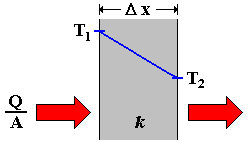 |
For a cast iron 0.012m (½") cylinder block at steady state, 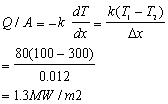 The following applet presents a simple conduction example, Conduction Applet. |
|||||||||||||||
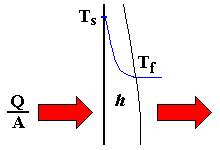 |
Convection heat transfer is energy transport due to bulk fluid motion. Convection heat transfer through gases and liquids from a solid boundary results from the fluid motion along the surface. Newton determined that the heat transfer/area, Q/A, is proportional to the fluid solid temperature difference Ts-Tf. The temperature difference usually occurs across a thin layer of fluid adjacent to the solid surface. This thin fluid layer is called a boundary layer. The constant of proportionality is called the heat transfer coefficient, h. Newton's Equation: The heat transfer coefficient depends on the type of fluid and the fluid velocity. The heat flux, depending on the area of interest, is the local or area averaged. The various types of convective heat transfer are usually categorized into the following areas : Table II. Convective Heat Transfer Coefficients
|
|||||||||||||||
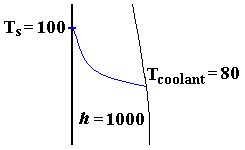 |
For a cylinder block with a forced convection h of 1000, surface temperature
of 100C , and a coolant temperature of 80 C, the local heat transfer rate
is :
Click here to activate the Convection Applet. |
|||||||||||||||
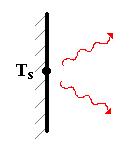 |
Radiation heat transfer is energy transport due to emission of electromagnetic waves or photons from a surface or volume. The radiation does not require a heat transfer medium, and can occur in a vacuum. The heat transfer by radiation is proportional to the fourth power of the absolute material temperature. The proportionality constant s is the Stefan-Boltzman constant equal to 5.67 x 10-8 W/m2K4. The radiation heat transfer also depends on the material properties represented by e, the emissivity of the material. For a surface with an emissivity of e = 0.8 and T = 373 K (100C), the radiation heat transfer is For moderate (less than 100 C) temperature differences, it should be noted that the radiation and natural convection heat transfer are about the same. The following applet calculates the heat transfered by radiation from a surface at temperature, Ts: Radiation Applet. |
 |
 |